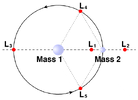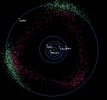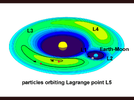You are using an out of date browser. It may not display this or other websites correctly.
You should upgrade or use an alternative browser.
You should upgrade or use an alternative browser.
Where will the point be located?
- Thread starter ольга
- Start date
DaveC426913
Valued Senior Member
That's a pretty broad question. And a bit ambiguous. Do you mean literally each object has the same attraction? Or do you simply mean that they are balanced, so that he object is stable?Is it possible to arrange an object in such a way that it win be evenly attracted by all the objects around it? For example, in the solar system?
It is possible to contrive a situation where a given set of objects are equally attracted to each other, for example a Klemperer rosette, but it's really difficult.
exchemist
Valued Senior Member
Lagrangian points?That's a pretty broad question. And a bit ambiguous. Do you mean literally each object has the same attraction? Or do you simply mean that they are balanced, so that he object is stable?
It is possible to contrive a situation where a given set of objects are equally attracted to each other, for example a Klemperer rosette, but it's really difficult.
Давайте представим себе гипотетическую ситуацию, что какая-нибудь планета солнечной системы по какой-либо причине взорвалась и распалась на мелкие обломки. Как изменятся орбиты остальных планет?That's a pretty broad question. And a bit ambiguous. Do you mean literally each object has the same attraction? Or do you simply mean that they are balanced, so that he object is stable?
It is possible to contrive a situation where a given set of objects are equally attracted to each other, for example a Klemperer rosette, but it's really difficult.
DaveC426913
Valued Senior Member
Yeah, I was going to go there next, once I established what Olga was thinking of.Lagrangian points?
DaveC426913
Valued Senior Member
Unless it were Jupiter, it would have virtually no effect, except in the very long term.Let's imagine a hypothetical situation where some planet in the solar system exploded for some reason and broke into small fragments. How would the orbits of the other planets change?
In practical terms an exploding Jupiter would distribute its mass in a lengthening arc along its orbit, a little like this:

So the effect on other planets wouild be incremental - i.e. it would affect them, but take quite a bit of time as mass redistributed itself.
By the way, the above pic is taken from a larger pic of Jupiter's trojan asteroids which clump around its orbit like this:

You can see it in action here:

LEARN - What is Asteroid Orbital Resonance? - Asteroid Day
Space Dance: How Planets Shape Asteroid Orbits, from Stability to Collision Risks
Разве исчезновение какой-либо из планет не изменило бы орбиты всех остальных? Ведь все планеты гравитационно связаны между собой?Unless it were Jupiter, it would have virtually no effect, except in the very long term.
In practical terms an exploding Jupiter would distribute its mass in a lengthening arc along its orbit, a little like this:
View attachment 6600
So the effect on other planets wouild be incremental - i.e. it would affect them, but take quite a bit of time as mass redistributed itself.
By the way, the above pic is taken from a larger pic of Jupiter's trojan asteroids which clump around its orbit like this:
View attachment 6601
You can see it in action here:

LEARN - What is Asteroid Orbital Resonance? - Asteroid Day
Space Dance: How Planets Shape Asteroid Orbits, from Stability to Collision Risksasteroidday.org
DaveC426913
Valued Senior Member
They're gravitationally bound to the sun, which is 99.86% of the mass of the solar system. Jupiter accounts for about 0.1% of the system, and all the planets, moons and asteroids account for the remaining, 0.6%.Wouldn't the disappearance of one of the planets change the orbits of all the others? After all, all the planets are gravitationally bound to each other?
So, even though the planets spend 50% of their time closer to each other than the sun is, they also spend 50% of their time farther from the sun. All told, they do little more than perturb the orbits of each other by a small bit.
It's not negligible. Perturbations of Uranus were what led us to discover Neptune.
Last edited:
А откуда тогда взялись точки Лагранжа?They're gravitationally bound to the sun, which is 99.86% of the mass of the solar system. Jupiter accounts for about 0.1% of the system, and all the planets, moons and asteroids account for the remaining, 0.6%.
So, even though the planets spend 50% of their time closer to each other than the sun is, they also spend 50% of their time farther from the sun. All told, they do little more than perturb the orbits of each other by a small bit.
It's not negligible. Perturbations of Uranus were what led us to discover Neptune.
DaveC426913
Valued Senior Member
Lagrange points are common to all two-body systems. That includes star/planet systems as well as planet/moon systems.Where did the Lagrange points come from then?

The Sun-Earth system has Lagrange points (James Webb Telescope is at Sun-Earth's L2, knowm as 'Trojans').

The Sun-Jupiter system has Lagrange points (the green objects in this diagram are at Sun-Jupiter's L4 and L5).

But even the Earth-Moon system has Lagrange points.

(This is much weaker though, so they haven't accumulated much except dust)
So, to bring it back to your question: yes, planets can gravitationally nudge each other around in their orbits, but no, they're not gravitationally bound.
At its extreme, some solar systems have synchronized their bodies. For example, recently discovered HD110067 has six planets all in resonance: 3:2, 3:2, 3:2, 4:3, and 4:3. Synchronizing the period of their orbits also requires the synchronization of their distances from the parent star - i.e. the planets have migrated over time to these stable orbital distances where they can maintain the resonances.
Last edited:
А как ведёт себя время в точках Лагранжа, по Вашему мнению?Lagrange points are common to all two-body systems. That includes star/planet systems as well as planet/moon systems.
View attachment 6603
The Sun-Earth system has Lagrange points (James Webb Telescope is at Sun-Earth's L2, knowm as 'Trojans').
View attachment 6605
The Sun-Jupiter system has Lagrange points (the green objects in this diagram are at Sun-Jupiter's L4 and L5).
View attachment 6602
But even the Earth-Moon system has Lagrange points.
View attachment 6604
(This is much weaker though, so they haven't accumulated much except dust)
So, to bring it back to your question: yes, planets can gravitationally nudge each other around in their orbits, but no, they're not gravitationally bound.
At its extreme, some solar systems have synchronized their bodies. For example, recently discovered HD110067 has six planets all in resonance: 3:2, 3:2, 3:2, 4:3, and 4:3. Synchronizing the period of their orbits also requires the synchronization of their distances from the parent star - i.e. the planets have migrated over time to these stable orbital distances where they can maintain the resonances.
DaveC426913
Valued Senior Member
The same as any other part of interplanetary space.How does time behave at Lagrange points, in your opinion?
Here is a diagram I drew up to show what the curvature of space is like around a two-body system - in this case the Sun-Earth system - but the Earth Moon system is virtually identical on a smaller - and flatter - scale.

You can see how the Lagrange points (yellow/flat) are much more like flat interplanetary space than they are like the gravity wells (blue/curved) that planets and moons are in.
Objects get stuck in these areas - not because they're wells - but simply because the gravitational potential is virtually the same in all directions, meaning there's not much to pull an object out of position. But they are not stable - if an object is nudged out of position, there's no restorative force, so it will eventually drift outside the point - which is why the JWST needs station-keeping thrusters.
Протон в точке Лагранжа будет вращаться вокруг собственной оси?The same as any other part of interplanetary space.
Here is a diagram I drew up to show what the curvature of space is like around a two-body system - in this case the Sun-Earth system - but the Earth Moon system is virtually identical on a smaller - and flatter - scale.
View attachment 6606
You can see how the Lagrange points (yellow/flat) are much more like flat interplanetary space than they are like the gravity wells (blue/curved) that planets and moons are in.
Objects get stuck in these areas - not because they're wells - but simply because the gravitational potential is virtually the same in all directions, meaning there's not much to pull an object out of position. But they are not stable - if an object is nudged out of position, there's no restorative force, so it will eventually drift outside the point - which is why the JWST needs station-keeping thrusters.
DaveC426913
Valued Senior Member
Being at a Lagrange point would have no effect on the rotation of a proton.Will a proton at a Lagrange point rotate around its own axis?
Т.е. он будет висеть неподвижно?Being at a Lagrange point would have no effect on the rotation of a proton.
Pinball1970
Valued Senior Member
The strong nuclear force is many orders of magnitude stronger than gravity, so are the other two forces.Т.е. он будет висеть неподвижно?
Gravity works over large distance scales and large bodies like, planets moons and suns.
The other three forces work at the molecular, atomic and subatomic level.
У них у всех одна природа.The strong nuclear force is many orders of magnitude stronger than gravity, so are the other two forces.
Gravity works over large distance scales and large bodies like, planets moons and suns.
The other three forces work at the molecular, atomic and subatomic level.
Pinball1970
Valued Senior Member
I am also not sure what you mean by "hang there," hang where? Which proton did you have in mind?Т.е. он будет висеть неподвижно?
Pinball1970
Valued Senior Member
Well no, they all do different things.У них у всех одна природа.
Они все стараются уравновеситься. Всё в природе старается уравновеситься.Well no, they all do different things.
